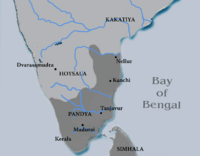Pandya dynasty facts for kids
 Extent of the Pandya Territories c. 1250 C.E. |
|
| Official language | Tamil |
| Capitals | Korkai Madurai |
| Government | Monarchy |
| Preceding state | Unknown |
| Succeeding states | Delhi Sultanate, Nayak, Vijayanagar |
The Pandya dynasty was an ancient Tamil kingdom in South India. It was one of the three main Tamil kingdoms. The other two were the Cholas and the Cheras. The rulers of these three kingdoms were known as the Three Crowned Kings of Tamilakam (the Tamil land).
The early Pandyas ruled parts of Southern India for a very long time. Their rule started around the 4th century BCE. It finally ended in the early 16th century CE.
They first ruled from Korkai. This was a seaport at the southern tip of India. Later, they moved their capital to Madurai. The Pandyas even had special connections with far-off places like the Roman Empire. Ancient writers described their land in different ways.
Contents
Pandya Land and Culture
The Pandya empire was home to many beautiful temples. Two famous ones are the Meenakshi Temple in Madurai and the Nellaiappar Temple in Tirunelveli.
During the early Pandya rule, different religions grew. These included Jainism, Shaivism (worship of Shiva), and Vaishnavism (worship of Vishnu). Later, after the Pandyas became strong again, Shaivite Nayanars and Vaishnavite Alvars became very important. These were groups of poet-saints.
The Pandyas were known for supporting literature. The famous Tamil Sangams (gatherings of poets and scholars) were held in Madurai. Some Pandya kings were even poets themselves.
Rise and Fall of the Pandyas
The early Pandya dynasty became less powerful for a while. This happened after the Kalabhras invaded. But the dynasty came back strong in the early 6th century. A ruler named Kadungon pushed the Kalabhras out. He then ruled from Madurai.
The Pandyas faced challenges again when the Cholas became powerful in the 9th century. The Pandyas and Cholas often fought. The Pandyas sometimes teamed up with the Sinhalese (from Sri Lanka) and the Cheras. They worked together against the Chola empire.
The Golden Age of the Later Pandyas
The Pandyas had a "golden age" in the late 13th century. This was during the time of the Later Pandyas (1216–1345). Kings like Maravarman Sundara Pandyan and Jatavarman Sundara Pandyan (around 1251) made the empire much bigger. They expanded into the Telugu country. They also conquered Kalinga (modern-day Orissa). They even invaded and conquered Sri Lanka.
The Pandyas were also very good at trade. They had strong trade links with powerful sea empires in Southeast Asia. These included Srivijaya and its successors. They controlled the pearl fisheries along the South Indian coast. This area between Sri Lanka and India produced some of the best pearls in the ancient world.
End of Pandya Rule
Throughout their history, the Pandyas often fought with other kingdoms. These included the Pallavas, Cholas, and Hoysalas. Finally, Muslim invaders from the Delhi Sultanate arrived. This led to the end of Pandya power in South India.
In 1323, the Jaffna Kingdom in Sri Lanka declared its freedom. It broke away from the weakening Pandya Empire. The Pandyas lost their capital city, Madurai, to the Madurai Sultanate in 1335. However, they moved their capital to Tenkasi. They continued to rule some smaller regions.
Later, the Madurai Sultanate was replaced by governors from the Vijayanagara Empire in 1378. In 1529, these governors declared their independence. They then set up the Madurai Nayak dynasty.
Images for kids
-
Vaigai River in Madurai
-
Enthroned god Vishnu, Pandya dynasty, second half of the 8th–early 9th century CE (Metropolitan Museum of Art, New York City)
-
Pandya country in the Chola Empire (12th century)
-
An aerial view of Madurai city from Meenakshi Temple
-
Ancient Silk Road trade routes
See also
 In Spanish: Dinastía Pandya para niños
In Spanish: Dinastía Pandya para niños









